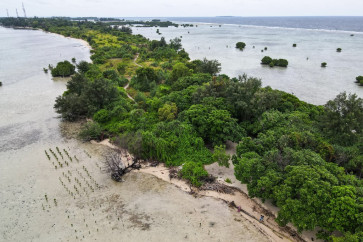Current El Nino third-strongest; expected to last until spring
A boy pulls from a donkey carrying tanks with water in the municipality of Texiguat, about 100 km southeast of Tegucigalpa, on July 26, 2015
Change Size
 A boy pulls from a donkey carrying tanks with water in the municipality of Texiguat, about 100 km southeast of Tegucigalpa, on July 26, 2015. Honduras has been hit by a major drought caused by "El Nino" climate phenomenon, a band of unusually warm Pacific ocean temperatures, which in the past has been linked to numerous floods, droughts and bush fires from South America to Australia. The drought has killed thousands of cattle and dried up crops. (AFP/Orlando Sierra) (AFP/Orlando Sierra)
A boy pulls from a donkey carrying tanks with water in the municipality of Texiguat, about 100 km southeast of Tegucigalpa, on July 26, 2015. Honduras has been hit by a major drought caused by "El Nino" climate phenomenon, a band of unusually warm Pacific ocean temperatures, which in the past has been linked to numerous floods, droughts and bush fires from South America to Australia. The drought has killed thousands of cattle and dried up crops. (AFP/Orlando Sierra) (AFP/Orlando Sierra)
A
span class="inline inline-center">A boy pulls from a donkey carrying tanks with water in the municipality of Texiguat, about 100 km southeast of Tegucigalpa, on July 26, 2015. Honduras has been hit by a major drought caused by "El Nino" climate phenomenon, a band of unusually warm Pacific ocean temperatures, which in the past has been linked to numerous floods, droughts and bush fires from South America to Australia. The drought has killed thousands of cattle and dried up crops. (AFP/Orlando Sierra)
The current El Nino phenomenon, a global weather pattern known to wreak havoc every few years, should last until spring and likely become one of the strongest on record, forecasters said Thursday.
That expected strength makes El Nino likely to peak in late fall or early winter and bring more precipitation than normal to the drought-stricken southwestern United States, the US Climate Prediction Center said.
"At this point it could be one of the three strongest El Ninos we have seen," Mike Halpert, deputy director of the center, told reporters.
Between June and August, average sea surface temperatures in affected regions were the third-warmest since record keeping began, the center said, behind 1987 and 1997.
"In any measure, 1997 was still stronger than we are seeing right now," said Halpert.
Forecasters placed the likelihood at 95 percent that this El Nino, in which warmer Pacific waters cause changes to global weather circulation, will last until spring.
And it placed the likelihood that the southwestern US states will see much-needed wetter-than-normal winters between 33 and 60 percent, depending on region.
But Halpert said the most reliable prediction they have regarding El Nino's impacts is that the Gulf of Mexico and bordering regions will have a wetter than normal winter.
"At this point we have fairly high probability for that," he said.
It is also expected to contribute to warmer than average temperatures in Alaska, Canada, and the northern, western and central United States.
Halpert noted that savings on heating bills would be welcome in places like North Dakota.
"El Nino actually is good for some parts of the country," he said. "They have done studies showing the US is one of the big winners economically regarding El Nino."
Due to its associated changes in sea surface temperatures, El Nino is expected to contribute to a below-normal hurricane season in the Atlantic and above-normal in the central and eastern Pacific.(++++)








![A man walks across a pedestrian crossing near a billboard depicting named Iranian ballistic missiles in service, with text in Arabic reading “the honest [person's] promise“ and in Persian “Israel is weaker than a spider's web“, in Valiasr Square in central Tehran on April 15, 2024. Iran on April 14 urged Israel not to retaliate militarily to an unprecedented attack overnight, which Tehran presented as a justified response to a deadly strike on its consulate building in Damascus.](https://img.jakpost.net/c/2024/04/16/2024_04_16_149344_1713260233._medium.jpg)
